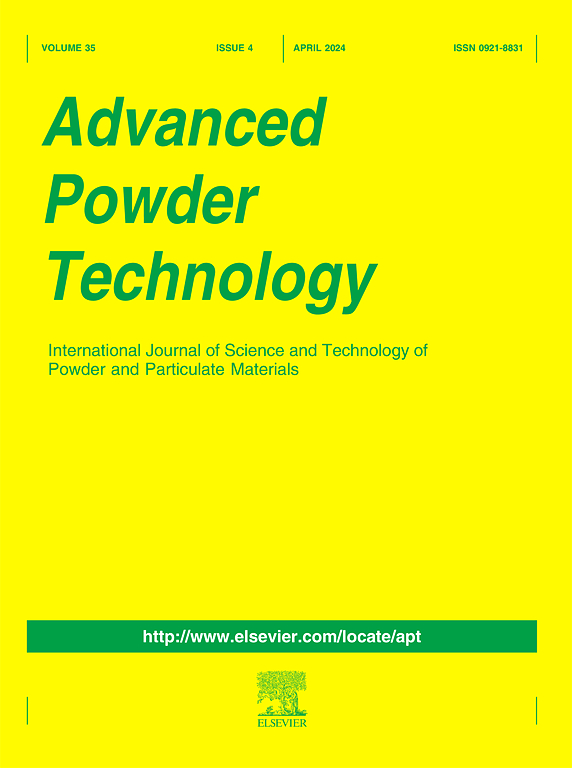Experimental and numerical study on the suppression of methane/coal dust hybrid explosion by DMMP water mist
IF 4.2
2区 工程技术
Q2 ENGINEERING, CHEMICAL
引用次数: 0
Abstract
To investigate the effect of DMMP (dimethyl methyl phosphonate) water mist on the suppression of methane/coal dust hybrid explosion, a series of experiments on methane/coal dust hybrid explosion suppressed by varying DMMP water mist (0 % DMMP-2.0 % DMMP) were carried out in a 20 L spherical device. The experimental results show that the flame propagation speed, maximum explosion pressure rise rate (dP/dt)max and explosion index KG first increase and then decrease with the increase of DMMP concentration. The optimal explosion suppression concentration of DMMP water mist for methane/coal dust hybrid explosion is 1.2 %. Besides, a new kinetic model of methane/coal dust hybrid explosion suppressed by DMMP water mist was established to analyze the chemical kinetics of the elementary reaction under different initial temperature (T0 = 1250–1600 K) and initial pressures (P0 = 0.08–0.13 MPa). The numerical results revealed that the elementary reaction R1: H + O2 = O + OH is the dominant elementary reaction to enhance adiabatic flame temperature. Phosphorus containing small molecules HOPO and HOPO2 are important intermediate products in the DMMP reaction process, playing a crucial role in the suppression of methane/coal dust hybrid explosion by DMMP water mist.

DMMP水雾抑制甲烷/煤尘混合爆炸的实验与数值研究
为了研究DMMP(二甲基膦酸甲酯)水雾对甲烷/煤尘混合爆炸的抑制作用,在20 L球形装置上进行了不同DMMP水雾(0% DMMP- 2.0% DMMP)对甲烷/煤尘混合爆炸的抑制实验。实验结果表明,随着DMMP浓度的增加,火焰传播速度、最大爆炸压力上升率(dP/dt)max和爆炸指数KG先增大后减小。DMMP水雾对甲烷/煤尘混合爆炸的最佳抑爆浓度为1.2%。此外,建立了DMMP水雾抑制甲烷/煤尘混合爆炸的新动力学模型,分析了不同初始温度(T0 = 1250 ~ 1600 K)和初始压力(P0 = 0.08 ~ 0.13 MPa)下的元素反应化学动力学。结果表明,R1: H + O2 = O + OH是提高绝热火焰温度的主要基本反应。含磷小分子HOPO和HOPO2是DMMP反应过程中重要的中间产物,在DMMP水雾抑制甲烷/煤尘混合爆炸中起着至关重要的作用。
本文章由计算机程序翻译,如有差异,请以英文原文为准。
求助全文
约1分钟内获得全文
求助全文
来源期刊

Advanced Powder Technology
工程技术-工程:化工
CiteScore
9.50
自引率
7.70%
发文量
424
审稿时长
55 days
期刊介绍:
The aim of Advanced Powder Technology is to meet the demand for an international journal that integrates all aspects of science and technology research on powder and particulate materials. The journal fulfills this purpose by publishing original research papers, rapid communications, reviews, and translated articles by prominent researchers worldwide.
The editorial work of Advanced Powder Technology, which was founded as the International Journal of the Society of Powder Technology, Japan, is now shared by distinguished board members, who operate in a unique framework designed to respond to the increasing global demand for articles on not only powder and particles, but also on various materials produced from them.
Advanced Powder Technology covers various areas, but a discussion of powder and particles is required in articles. Topics include: Production of powder and particulate materials in gases and liquids(nanoparticles, fine ceramics, pharmaceuticals, novel functional materials, etc.); Aerosol and colloidal processing; Powder and particle characterization; Dynamics and phenomena; Calculation and simulation (CFD, DEM, Monte Carlo method, population balance, etc.); Measurement and control of powder processes; Particle modification; Comminution; Powder handling and operations (storage, transport, granulation, separation, fluidization, etc.)
 求助内容:
求助内容: 应助结果提醒方式:
应助结果提醒方式:


